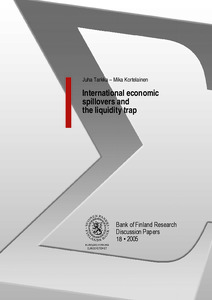International economic spillovers and the liquidity trap
Tarkka, Juha; Kortelainen, Mika (08.06.2005)
Numero
18/2005Julkaisija
Suomen Pankki
2005
Julkaisun pysyvä osoite on
https://urn.fi/URN:NBN:fi:bof-20140807394Tiivistelmä
We study the effect of the zero bound constraint of interest rates on international transmission of economic policy and supply shocks. After some preliminary analysis with a simple theoretical model, we apply a rich two-country simulation model to the problem.The model framework consists of EDGE, Bank of Finland's dynamic equilibrium model for the euro area, linked to a similar model calibrated to resemble the US economy.The models have new Keynesian properties because of price rigidities and forward-looking pricing, consumption and investment behaviour.We assume freely floating exchange rates.Monetary policies are modelled with Taylor type policy rules, taking into account the zero bound constraint for interest rates.We find that effects of policy and supply side shocks differ significantly from the 'normal' situation if one of the countries is in the 'liquidity trap', ie if the interest rate is constrained by the zero bound.Being in the liquidity trap amplifies the domestic effects of fiscal policy, but mitigates its spillover to abroad.Changing the long run inflation target, which does not have international spillovers in the normal case, does have effects abroad if the country where the target is changed is in a temporary liquidity trap.The effects of supply shocks are also very different in the liquidity trap case compared to the normal case. Key words: zero bound, liquidity trap, international spillovers, edge JEL classification numbers: F42, F47
